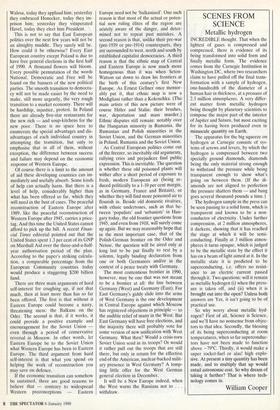SCENES FROM SCIENCE
Metallic hydrogen
INCREDIBLE thought. That when the lightest of gases is compressed and compressed, there is evidence of its being transformed into solid form and finally metallic form. The evidence comes from the Carnegie Institution in Washington DC, where two researchers claim to have pulled off the final trans- formation with a sample of hydrogen, one-hundredth of the diameter of a human hair in thickness, at a pressure of 2.5 million atmospheres. A very differ- ent matter from metallic hydrogen being thought by planetary scientists to compose the major part of the interior of Jupiter and Saturn, but most exciting for its having been produced even in minuscule quantity on Earth.
The apparatus for the big squeeze on hydrogen at Carnegie consists of sys- tems of screws and levers, by which the hydrogen is compressed between two specially ground diamonds, diamonds being the only material strong enough to withstand the pressure while being transparent enough to show what's going on between them. (If the di- amonds are not aligned to perfection the pressure shatters them — and bang goes several thousand pounds a time.) The hydrogen sample in the press can be seen passing to a solid form, which is transparent and known to be a non- conductor of electricity. Under further compression, at 2 million atmospheres, it darkens, showing that it has reached the stage at which it will be semi- conducting. Finally at 3 million atmos- pheres it turns opaque, which is judged to be the metallic state by the effect it has on a beam of light aimed at it. In the metallic state it is predicted to be superconducting, i.e. offers no resist- ance to an electric current passed through it. Two questions: will it remain as metallic hydrogen (i) when the press- ure is taken off, and (ii) when it is brought out into the open? Unless both answers are Yes, it isn't going to be of, practical use.
So why worry about metallic hyd- rogen? First of all, Science is Science, and we'll have no nonsense from objec- tors to that idea. Secondly, the blessing of its being superconducting at room temperatures, when so far superconduc- tors have not been made to function above —79°C. Thirdly, it would make a super rocket-fuel or alas! high explo- sive. At present a tiny quantity has been made, and to multiply that up would entail astronomic cost. So why dream of taking it further? That is where tech- nology comes in.
William Cooper










































 Previous page
Previous page